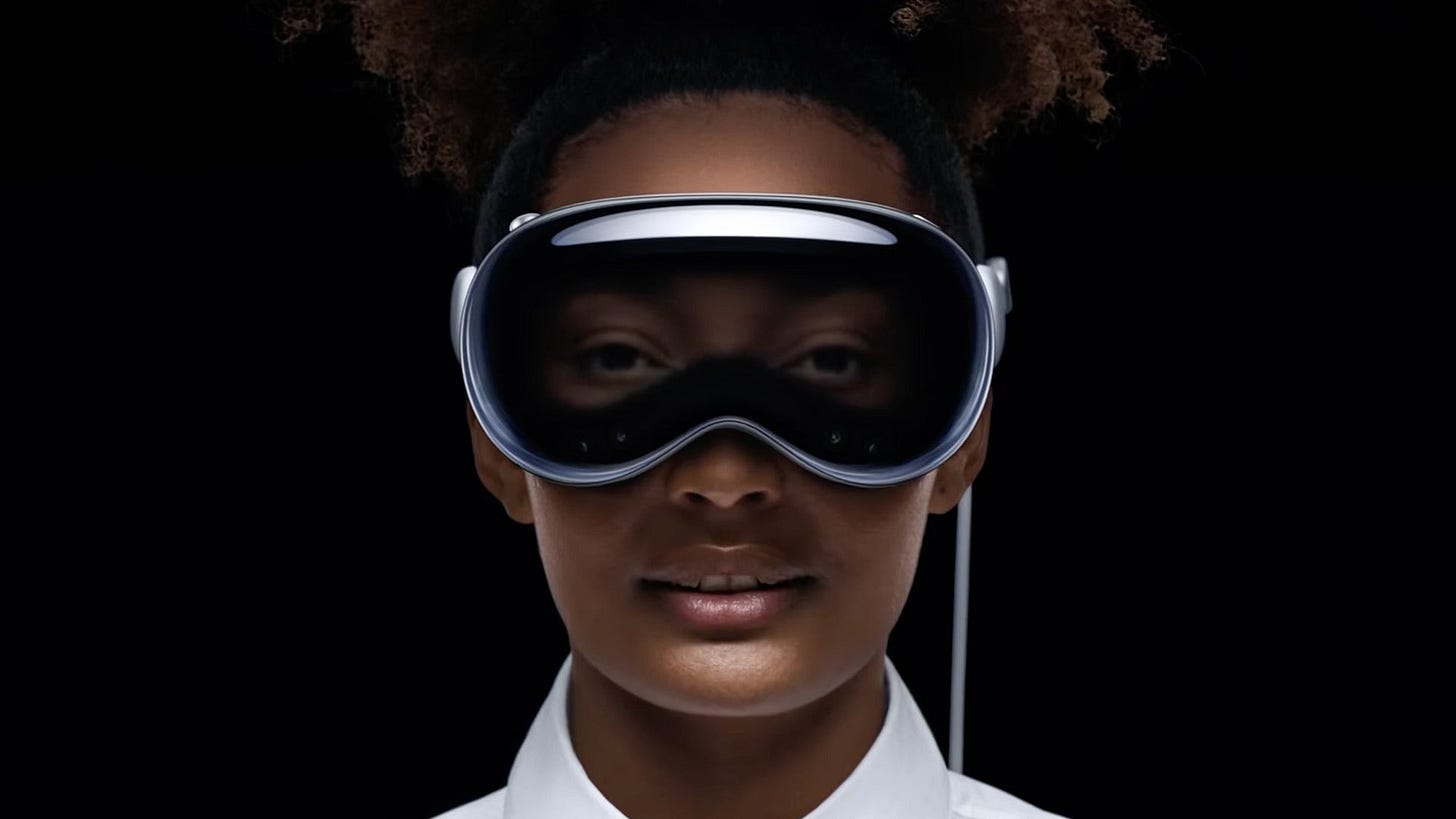On February 2nd, the Apple Vision Pro is set to be released, marking a pivotal moment in potentially integrating augmented and immersive experiences into our daily lives. This event reminds me of the launch of the first iPhone, which revolutionized how we connect with others through mobile devices. Although the impact of the Apple Vision Pro might not match the magnitude of the iPhone's debut, it shares many foundational similarities.
1. Setting the Stage
Just as bulky, briefcase-sized cell phones of the 1990s laid the groundwork for the sleek iPhone, the journey of VR technology has been similar. Early VR headsets, known for their cumbersome design and uncomfortable user experience, have gradually evolved to become more comfortable, powerful, and user-friendly.
The Apple Vision Pro represents a significant step forward in this evolution. Natural hand and eye movements have now replaced the clunky joysticks of other headsets. The sleek design and passthrough technology allow users to remain in their real world space while dipping their toes into an immersive experience. There are also more productivity features that previous systems did not entail that could persuade users to use it with more regularity.
2. Business Interests and New Opportunities
The iPhone's launch opened up unprecedented business opportunities, and the Apple Vision Pro is poised to do the same for immersive experiences. Major retailers like Walmart are already investing in augmented reality (AR) applications, seeing the potential for profit in this new technology. AR could revolutionize e-commerce, from virtually trying on shoes to seeing how a new bookshelf fits in your living room. While the idea of a virtual Walmart may seem cringy, the investment of such large companies in AR technology is crucial. It encourages further development by companies like Apple, creating new opportunities for creative professionals.
3. Revolutionizing Storytelling
The iPhone has ushered in the era of short-form video, a new visual medium that has transformed how we create and consume content. Now…don’t get me wrong…I’m not the biggest fan of short-form media, but it is hard to argue it’s impact on visual storytelling for an entire generation.
Similarly, immersive experiences offer a groundbreaking way to tell stories, potentially transforming the narrative landscape significantly and engagingly.
During my tenure at Blue Sky Studios, artists began experimenting with virtual reality (VR) to tell stories, immersing audiences in the worlds we created. My colleague, Daniel Abramovici, played a pivotal role in this venture. Our discussions about this new storytelling format were eye-opening.
One striking aspect of VR is the absence of a traditional film frame. Unlike movies, where the director controls the viewer's focus within a confined space, VR allows the audience to explore, move, and look around freely. This freedom poses an intriguing question: how does one craft a narrative in an environment where the viewer controls where to look?
Another immediate consideration is the portrayal of scale in VR. In traditional film, characters are usually presented at a consistent eye level, regardless of their size. The 5' 7" tall Tom Cruise can maintain eye contact with his fellow actors, irrespective of the greater height of Nicole Kidman.
However, in a VR environment, there's no place to hide discrepancies in scale. For instance, how would a conversation between a 10-foot tall elephant and a mouse on the ground be perceived by the audience? Would you want to the viewer to stand back to take everything in? Just look up and down? Or maybe they would need to lie on the ground just to hear the mouse?
Interactivity is another element of Immersive Storytelling. What if the audience could interact with objects in the virtual environment? How would that influence the narrative?
Augmented reality (AR) adds another layer to this discussion. Imagine a scenario where characters are aware of and can interact with the architecture of your home, performing in your own living and dining rooms. This could profoundly alter the storytelling experience.
There are more questions than answers at this stage, but this uncertainty makes exploring VR and AR storytelling so thrilling. As natural storytellers, we have enormous potential to discover and develop innovative methods in these mediums.
4. Examples of Broader Acceptance On AR
For those skeptical of immersive or augmented experiences becoming widely adopted by the general public, I have one argument for you. It’s already happened to the most popular sport in America.
For those who might not be familiar with American football, here's a quick rundown of the game's basic rules. A team is given four attempts, known as "plays," to move the football forward by at least 10 yards. If they succeed in moving the ball past this 10-yard mark, they are awarded another set of four plays to advance an additional 10 yards from their new position. This process continues, play-by-play, as the team progressively moves the ball across the field. The ultimate goal is to carry the ball to the end of the field or to successfully kick it through a large, yellow 'Y'.
Prior to AR, viewers were never 100% sure where that goal was on any given play. In 1998, a broadcast tried just adding a simple, virtual yellow line to indicate that goal. This simple yet effective innovation enhanced viewers' experience and was quickly embraced, even by older audiences. It was simple and clean and provided enormous value to the end user. It demonstrates that augmented experiences can have wide adoption if they are well-designed and provide value.
The Challenges: Size, Clunkiness, and Cost
Believe me I know the argument against it. The Vision Pro is big. It’s clunky. And it’s got a huge price tag!
To that point, I agree and why I think we are probably still a couple of versions away from wide adoption…but here is the counterargument.
It’s Apple
There are a handful of companies that just seem to operate on a different branding level than everyone else. Pixar, Nike, and Google are up there but Apple leads the pack with customer loyalty and engagement. They have earned that right by making products that stand out from the competition and generally high quality and deliver on their promises.
This will lead to a person saying the Meta Quest 3 is too expensive at $1,000 and that exact same person saying the Apple Vision Pro is revolutionary at $3,500. Apple doesn’t operate by the same rules as other companies. It’s convinced people to pay $999 for a monitor stand or $79 for a charging cable. Despite the excitement, the Apple Vision Pro faces criticisms for its size, cumbersome design, and high price tag.
Join the Immersive Experience Movement
I'm eager to delve into building immersive experiences and want to connect with like-minded creators. If you're interested in joining a community focused on developing AR/VR content, please contact me at michaeltanzillo@gmail.com. Let's explore this exciting new frontier together!
3D News of the Week
Unity is laying off 25 percent of its staff - The Verge
Animal Logic to merge into Netflix Animation - kidscreen
The Fashion Technology Agenda 2024 - LinkedIn
Marvel Snap maker gets $100M funding for ‘years’ of development, plus new IP - Polygon.com
Free Hair Brush for ZBrush from Former Overwatch Character Artist - 80.lv
3D Merch is here!
Click here to Get Your 3D Artist Swag!
3D Tutorials
3D Job Spreadsheet
Link to Google Doc With A TON of Jobs in Animation (not operated by me)
Check Out The New Wednesday Artist Spotlight Email!
LINK TO ARTIST SPOTLIGHT
Want to be featured!?!?! Submit your work here
Hello! Michael Tanzillo here. I am the Head of Technical Artists with the Substance 3D Growth team at Adobe. Previously, I was a Senior Artist on animated films at Blue Sky Studios/Disney with credits including three Ice Age movies, two Rios, Peanuts, Ferdinand, Spies in Disguise, and Epic.
In addition to his work as an artist, I am the Co-Author of the book Lighting for Animation: The Visual Art of Storytelling and the Co-Founder of The Academy of Animated Art, an online school that has helped hundreds of artists around the world begin careers in Animation, Visual Effects, and Digital Imaging. I also created The3DArtist.Community and this newsletter.
www.michaeltanzillo.com
Free 3D Tutorials on the Michael Tanzillo YouTube Channel
Thanks for reading The 3D Artist! Subscribe for free to receive new posts and support my work. All views and opinions are my own!











Huge proponent of AR here. Unfortunately, the price tag is prohibitive, and I'm reading about concerns of the weight of the device and related headaches, etc., among other things.
It's moving forward ... but slowly.